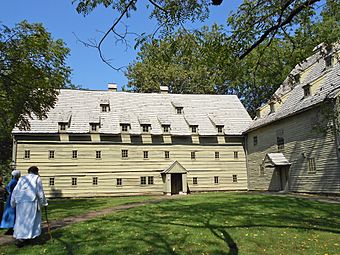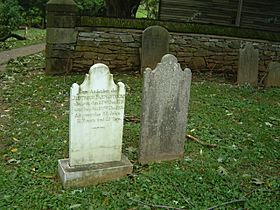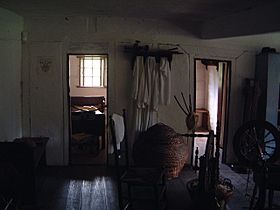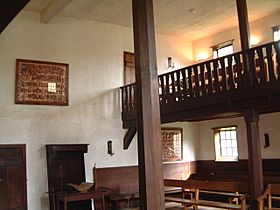Ephrata Cloister facts for kids
|
Ephrata Cloister
|
|

Women's Building and Meetinghouse
|
|
| Lua error in Module:Location_map at line 420: attempt to index field 'wikibase' (a nil value). | |
| Location | Jct. of US 322 and 272, Ephrata, Pennsylvania, United States |
|---|---|
| Area | 30 acres (12 ha) |
| Built | 1732 |
| NRHP reference No. | 67000026 |
Quick facts for kids Significant dates |
|
| Added to NRHP | December 24, 1967 |
| Designated NHL | December 24, 1967 |
The Ephrata Cloister was a special religious community. It was started in 1732 by a man named Conrad Beissel in Ephrata, Pennsylvania. This area is now part of Lancaster County, Pennsylvania. Today, the land and buildings of the community belong to the state of Pennsylvania. The Pennsylvania Historical and Museum Commission takes care of them.
The last person who lived at the Ephrata Cloister, Marie Kachel Bucher, passed away on July 27, 2008. She was 98 years old.
Contents
A Unique Community's Story
The Ephrata Cloister grew from a religious movement called the Schwarzenau Brethren. This group came from Germany. In 1728, some members formed a new group called the Seventh Day Dunkers. Their main belief was that Saturday, not Sunday, was the true day of rest, or Sabbath.
Starting the Ephrata Cloister
In 1732, Conrad Beissel arrived in Lancaster County, Pennsylvania. He settled by the Cocalico Creek. People were drawn to his leadership. Soon, a unique community began to form around him. It was named "Ephrata" after a place mentioned in the Bible.
This community was like a monastery and a convent. It had a Sister House for women and a Brother House for men. Members of the order chose to live a celibate life, meaning they did not marry. They lived very simply. They slept on narrow wooden benches, only 15 inches (380 mm) wide. Their pillows were wooden blocks! They slept for six hours each night. They also took a two-hour break to "watch" for the return of Christ.
Daily Life and Beliefs
Life at Ephrata was focused on prayer and work. Members ate only one small vegetarian meal a day. The only time they ate meat was during a special communion meal, where lamb was served. Beissel led long services every Saturday. These services often lasted for several hours.
Many people at this time wanted to practice their religion away from official state churches. The Ephrata community offered a way to live a strict religious life. They believed in helping others become more spiritual. They also encouraged a celibate lifestyle.
Family Life and Work
Not everyone at Ephrata lived a celibate life. There was also a group of married families, called householders. These families lived nearby and supported the community. They helped with daily tasks and activities.
The Cloister members were very busy. They did farming and industrial work. They were skilled in carpentry and papermaking. They also gardened, prepared meals, and mended clothes. They even manufactured clothing in a mill.
Education and Helping Others
The Ephrata Cloister valued education. They made sure that all children, including those from the householder families, went to the German school. Teaching the young was one of their important charity works. They also helped poor families by giving them bread.
The community had a positive view of life. They respected their neighbors, their land, and the environment.
Music and Printing
The brothers and sisters of Ephrata were famous for their writing. They published many hymns and composed music. Beissel was both the community's composer and spiritual leader. He even created his own system for writing music. Their first hymnal, with just the words, was printed in 1747.
The Ephrata Cloister had the second German printing press in the American colonies. They also printed the largest book in Colonial America. This book was called Martyrs Mirror. It told the stories of Christian martyrs who died for their faith. Before printing, the book had to be translated from Dutch into German. Peter Miller from Ephrata did this important translation. The printing started in 1748 and took about three years to finish.
Changes Over Time
Conrad Beissel passed away in 1768. After his death, fewer people joined the community. The celibate way of life slowly ended. The last celibate member died in 1813.
In 1814, the community became known as the German Seventh Day Baptist Church. Other branches of this church were started in different places. Two of these branches still exist today.
In 1941, 28 acres (110,000 m²) of the Ephrata land, with its remaining buildings, were given to the state of Pennsylvania. It became a state historical site. Archaeologists later explored the site. They discovered that the Cloister was used as a hospital during the American Revolutionary War (1775–1783).
A very special discovery happened in 1998. Archaeologists found the only glass trumpet of its kind in North America at the Cloister. It was in excellent condition, suggesting it might have been buried on purpose. Only the mouthpiece was missing.
At its busiest time, the Ephrata community covered 250 acres (1.0 km²). About 80 celibate men and women lived there. The married congregation had around 200 members.
Gallery
-
WPA poster, 1936–1941
See also
- Julius F. Sachse, a historian who studied the community
- List of the oldest buildings in Pennsylvania






